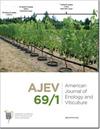长期和加速条件下罐装葡萄酒中硫化氢的形成
IF 1.8
3区 农林科学
Q3 BIOTECHNOLOGY & APPLIED MICROBIOLOGY
引用次数: 1
摘要
铝饮料罐中的葡萄酒(“罐装葡萄酒”)是一个快速增长的包装部分,由于几个因素,包括方便和可持续性。然而,罐装葡萄酒含有高浓度的硫化氢(h2s;“臭鸡蛋”)比玻璃包装的葡萄酒要多。我们假设葡萄酒成分和内衬的选择影响了罐头葡萄酒中h2s的形成。本文章由计算机程序翻译,如有差异,请以英文原文为准。
Hydrogen Sulfide Formation in Canned Wines under Long–Term and Accelerated Conditions
Background and goals Wines in aluminum beverage cans (“canned wines”) are a rapidly growing packaging segment due to several factors, including convenience and sustainability. However, canned wines have higher concentrations of hydrogen sulfide (H 2 S; “rotten egg”) than wines in glass packaging. We hypothesized that wine composition and liner selection affect H 2 S formation in canned wines.
求助全文
通过发布文献求助,成功后即可免费获取论文全文。
去求助
来源期刊

American Journal of Enology and Viticulture
农林科学-生物工程与应用微生物
CiteScore
3.80
自引率
10.50%
发文量
27
审稿时长
12-24 weeks
期刊介绍:
The American Journal of Enology and Viticulture (AJEV), published quarterly, is an official journal of the American Society for Enology and Viticulture (ASEV) and is the premier journal in the English language dedicated to scientific research on winemaking and grapegrowing. AJEV publishes full-length research papers, literature reviews, research notes, and technical briefs on various aspects of enology and viticulture, including wine chemistry, sensory science, process engineering, wine quality assessments, microbiology, methods development, plant pathogenesis, diseases and pests of grape, rootstock and clonal evaluation, effect of field practices, and grape genetics and breeding. All papers are peer reviewed, and authorship of papers is not limited to members of ASEV. The science editor, along with the viticulture, enology, and associate editors, are drawn from academic and research institutions worldwide and guide the content of the Journal.
 求助内容:
求助内容: 应助结果提醒方式:
应助结果提醒方式:


